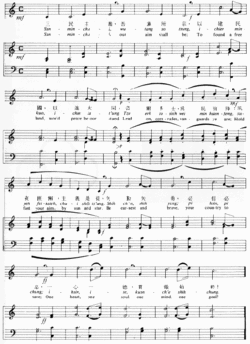You can help expand this article with text translated from the corresponding article in Chinese. (January 2022)Click [show] for important translation instructions.
|
| English: National Anthem of the Republic of China | |
|---|---|
 Sheet music | |
National anthem of the Republic of China Party anthem of the Kuomintang | |
| Lyrics | Sun Yat-sen, 1924 [note 1] |
| Music | Cheng Maoyun, 1928 |
| Adopted | 1930 (in Mainland China) 1945 (in Taiwan) |
| Relinquished | 1949 (in Mainland China) |
| Audio sample | |
Instrumental version of the National Anthem of the Republic of China | |
| National Anthem of the Republic of China | |||||||||||||||||||||||||||||||||||||
|---|---|---|---|---|---|---|---|---|---|---|---|---|---|---|---|---|---|---|---|---|---|---|---|---|---|---|---|---|---|---|---|---|---|---|---|---|---|
 The original Whampoa Military Academy speech in Sun's handwriting. | |||||||||||||||||||||||||||||||||||||
| Traditional Chinese | 中華民國國歌 | ||||||||||||||||||||||||||||||||||||
| Simplified Chinese | 中华民国国歌 | ||||||||||||||||||||||||||||||||||||
| Hanyu Pinyin | ZhōnghuáMínguóguógē | ||||||||||||||||||||||||||||||||||||
| |||||||||||||||||||||||||||||||||||||
| Three Principles of the People | |||||||||||||||||||||||||||||||||||||
| Traditional Chinese | 三民主義歌 | ||||||||||||||||||||||||||||||||||||
| Simplified Chinese | 三民主义歌 | ||||||||||||||||||||||||||||||||||||
| Hanyu Pinyin | Sānmín ZhǔyìGē | ||||||||||||||||||||||||||||||||||||
| Literal meaning | Three Principles of the People | ||||||||||||||||||||||||||||||||||||
| |||||||||||||||||||||||||||||||||||||
| National anthems of China | ||||||||||||||||||||||
|---|---|---|---|---|---|---|---|---|---|---|---|---|---|---|---|---|---|---|---|---|---|---|
| ||||||||||||||||||||||
The "National Anthem of the Republic of China", also known by its incipit "Three Principles of the People", is the national anthem of the Republic of China, commonly called Taiwan, as well as the party anthem of the Kuomintang. It was adopted in 1930 as the national anthem and was used as such in both mainland China and Taiwan until 1949, when the Republic of China central government relocated to Taiwan following its defeat by the Chinese Communist Party in the Chinese Civil War. It replaced the "Song to the Auspicious Cloud", which had been used as the Chinese national anthem before. The national anthem was adopted in Taiwan (per its return to Chinese rule) on October 25, 1945 after the surrender of Imperial Japan. Mainland China, being governed by the People's Republic of China today, discontinued this national anthem for "March of the Volunteers".
Contents
- History
- Tune
- Lyrics
- English translations
- Transcriptions in other Sinitic languages
- Notes
- References
- Further reading
- External links
The national anthem's words are adapted from a 1924 speech by Sun Yat-sen in 1927. The lyrics relate to how the vision and hopes of a new nation and its people can be achieved and maintained. [1] Informally, the song is sometimes known as "San Min Chu-i" from its opening line, which references the Three Principles of the People (三民主義; sānmín zhǔyì; san1-min2 chu3-i4), but this name is never used on formal or official occasions. During flag-raising ceremonies, the national anthem is played at the start prior to flag-raising followed by the National Flag Anthem of the Republic of China during actual flag-raising.
